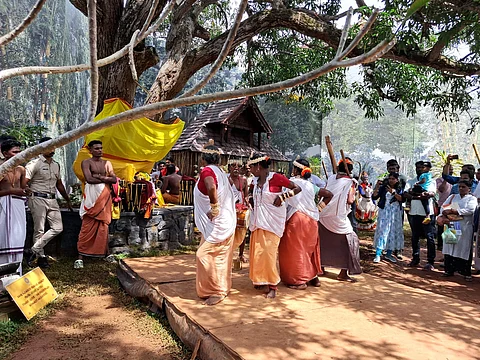

Aadimam Living Museum, an initiative by the Kerala Folklore Academy, to showcase the art forms of select tribes in Kerala in an immersive environment at the recently concluded Keraleeyam festival, has sparked a controversy with activists equating it with ‘human zoo’, a colonial era practice of displaying indigenous people. Even K Radhakrishnan, Minister for Welfare of Scheduled Caste and Scheduled Tribes expressed his reservations against it.
Keraleeyam, an annual event designed to showcase the world-class features of Kerala to the global community, began on November 1 and ended on November 7, 2023.
The Aadimam exhibition based on the Living Museum concept, showcased the traditional huts of various indigenous communities, including the Kaani, Mannan, Paliyar, Mavilar, and Uralis, along with their art forms, which are intrinsically connected to their livelihoods. Their huts, worship places, traditional attires, cooking culture and art forms were displayed. Living Museum is a type of museum which recreates historical settings to simulate a past time period, often with indigenous people as stakeholders if they are the focal point.
This led to widespread criticism on social media as they considered it an affront to the dignity of tribespeople who were being gawked at and photographed as ‘museum pieces’. The Kerala Folklore Academy under the Department of Culture, has since then vehemently denied the allegations.
The controversy erupted after photographs appeared on social media. Tribal rights activists compared it to a human zoo and claimed that it was an insult to the communities.
Dinu Veyil, a Dalit and gender rights activist, said it was an injustice to tribal communities. “There were two exhibitions at Keraleeyam, one on women who were torch bearers of Kerala development. Why didn’t anyone think of bringing them in person and making them sit there?” asked Dinu while participating in a panel discussion on Mathrubhumi news channel. He also said the tribespeople were forced to stay in the huts for seven days but were paid only Rs 1000 per day, which is nothing but social exploitation.
Dhanya Raman, a tribal rights activist, called for the resignation of Kerala Folklore Academy Chairman OS Unnikrishnan, saying it was demeaning. She also asked why no tribal art form or artist was given a space on the main venue, which had the presence of actors, Mammooty, Mohanlal and Sobhana during the inaugural function.
Commenting on the use of a photograph depicting Mannans in their traditional dress used for Mannan Koothu, by some social media users to criticise the event, Anu Pappachan, writer and critic, said the comparison with costumes in Bamboo Boys, a film criticised for stereotyping tribespeople, was not factual. The costume has been used by Mannan koothu performers before, she said on Facebook.
“If they were brought to Keraleeyam for seven days to introduce and invigorate their art form and help them gain some income from it, this is not the way to do it. Rather than making them mere objects to be gawked at, and mere selfies for visitors, they should have been given an opportunity to present it in the main stage after providing decent remuneration.
Folklore Academy Chairperson OS Unnikrishnan said the event was not created to display tribespeople but to showcase their art forms. ¨Aadimam Gothra Bhoomika was a major attraction at Keraleeyam. Now, all people from these communities do not live in houses as portrayed, they don’t wear these types of clothes, Kerala has developed and moved forward. They are wearing their traditional attire only to perform their art forms. When one group performs others will take rest. Aadhimam is a reinstallation of the history and heritage of a population,¨ he said.
As Telangana, Mizoram, MP, Chhattisgarh, & Rajasthan go to the polls, TNM and Newslaundry are joining forces to bring you the best on-ground reportage and analysis. Click here to support our election fund.
Organisers said the controversy happened because some people took photographs of tribal artists as they were resting after the performance. “When one group presents, others will take rest, so what can we do? Some people posted photos of artists taking rest and claimed it’s like a human zoo. They can't perform for 12 hours continuously,” said an official.
The tribal artists TNM spoke to were not happy about the controversy and also reluctant to speak to the media. ¨We are not here as displayed objects. We perform our artforms and we are being paid for it. We are proud to perform it. People flock in here to enjoy our art forms. I don't want to talk about it,” said a woman performer.
Another artist said it provided an opportunity for them. “We are proud of performing here. We perform across Kerala and are paid for it. This is the first time we are invited to perform at a traditional set up, which we are happy about. After the performance people come to take photos with us, it is not because we were kept for display,¨ he said.
The performers were paid Rs 1000 per day excluding their daily expenses and provided with accommodations outside.
“The criticism raised regarding the depiction of tribespeople during an exhibition at Kanakakunnu has been brought to our notice. The Department for SC/ST Welfare is not engaged in the conduct of any such exhibition. If such things have happened we will examine it and amendments would be made,” said a response from the office of K Radhakrishnan.